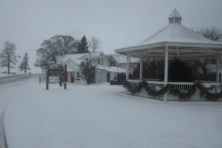Sister Bay Modifies Sign Ordinances
- Share
- Tweet
- Pin
- Share
The Village of Sister Bay has modified its sign ordinance to relax restrictions on businesses, including changes that give owners of large buildings much greater flexibility in designing signage.
Businesses had been limited to 24 square feet of signage under the old ordinance, but now businesses will be allotted square footage in proportion to the size of the building.
Village Administrator Bob Kufrin said the goal of the changes is to make a simpler, more coherent, and user-friendly sign ordinance.
Mitch Larson, owner of the On Deck Clothing Store building on the corner of Maple St. and Highway 42, applauded the changes.
“Anything they can do to help make it easier for businesses is good,” he said. “It accommodates larger businesses. I just hope there aren’t any holes that would allow something really tacky to slip by.”
Larson’s building houses three separate businesses, but under the previous ordinance it was difficult to give each business adequate signage. Now he has more square feet of signage to split up and more flexibility in the style of those signs.
Sign size will be determined by the width of the building that houses a business. For example, a 25-foot-wide building can have a sign of 18.5 square feet, while a 100-foot-wide building can have a sign of 59.4 square feet. It also takes building height into consideration. A two-story building will be allowed 10 percent more square footage, and a three-story building gets 20 percent more.
Existing signs are grandfathered in and don’t need to be altered.
Under the old ordinance, a huge building like that of the Sister Bay Bowl was limited to the same square footage of signage as the tiny Door County Ice Cream Factory Scoop Shop across the street.
“The question for the commission became this: Does a 20-foot-wide building need the same signage as a 200-foot-wide building?” Kufrin said.
The sign square footage can be split among several signs. Shopping centers – such as Pamida or the Country Walk Shops – will be allowed to have a master identification sign of up to 48 square feet in addition to building signs.
The village has also relaxed its rules regarding sign colors, allowing for greater leeway for accent colors to give businesses and sign makers more creative options. The village still has preferred colors approved for the primary parts of the sign.
The new ordinance allows for more temporary special event signs as well. In the past, Kufrin said every type of sign required a permit.
“A lot of those were routine signs for charities or for seasonal produce like Pumpkins for sale,” Kufrin said. “Now those don’t require a permit as long as they conform to the sign code requirements.”
Kufrin’s said many of those types of signs were innocuous and not worth the paperwork and enforcement effort.
“Even though the permit only costs $10 – $20, which may not seem like a lot, many of these fundraisers don’t make a lot of money,” he said.
The ordinance also puts sandwich board into two classifications. If the board changes regularly – advertising daily specials or sales – it doesn’t count toward total signage. If a business puts the same sign out every day without changes, it would count toward the total signage allotted to the building.


